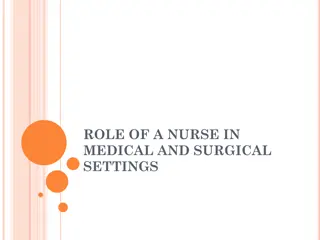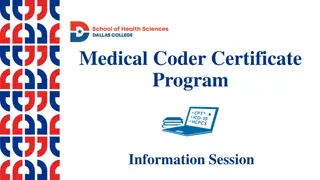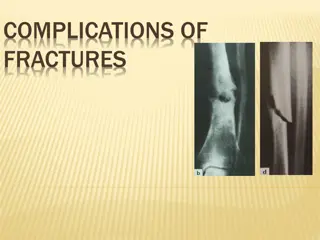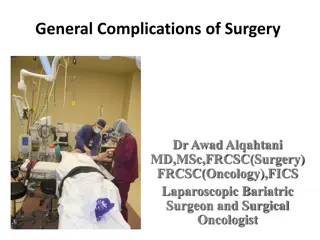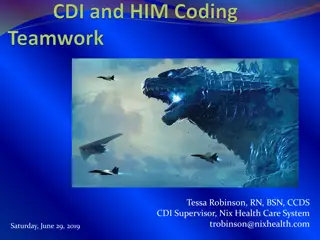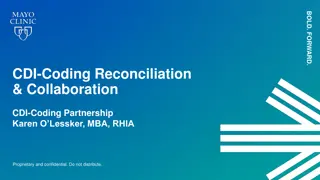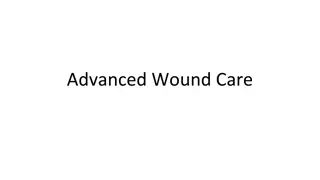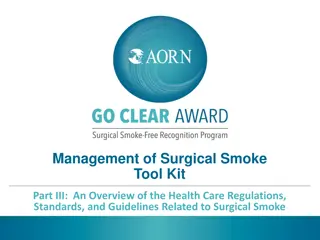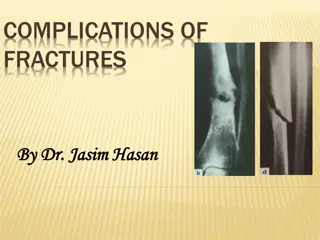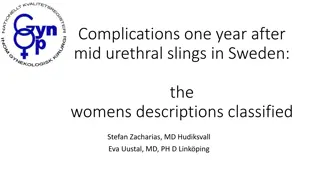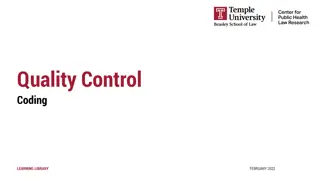Guidelines for Coding Complications of Medical & Surgical Care
Proper documentation and coding of complications of medical and surgical care are essential for accurate classification and billing. Assigning codes based on the provider's documentation of the relationship between the condition and care is crucial. Complications must be clearly documented with a cause-and-effect relationship indicated. Code sequencing is important to ensure specificity, with additional codes used if needed. Refer to the official guidelines and resources for accurate coding of complications in healthcare settings.
Download Presentation

Please find below an Image/Link to download the presentation.
The content on the website is provided AS IS for your information and personal use only. It may not be sold, licensed, or shared on other websites without obtaining consent from the author.If you encounter any issues during the download, it is possible that the publisher has removed the file from their server.
You are allowed to download the files provided on this website for personal or commercial use, subject to the condition that they are used lawfully. All files are the property of their respective owners.
The content on the website is provided AS IS for your information and personal use only. It may not be sold, licensed, or shared on other websites without obtaining consent from the author.
E N D
Presentation Transcript
Coding for Complications of Medical & Surgical Care BETH BURGESS, MHA, RHIA, CCS
Documentation of Complications of Care Official Coding Guidelines Section I.B.16 Code assignment is based on the provider's documentation of the relationship between the condition and the care or procedure, unless otherwise instructed by the classification. The guideline extends to any complications of care, regardless of the chapter the code is located in. It is important to note that not all conditions that occur during or following medical care or surgery are classified as complications. There must be a cause-and-effect relationship between the care provided and the condition, and an indication in the documentation that it is a complication. Query the provider for clarification, if the complication is not clearly documented.
Documentation of Complications of Care Must be more than a routinely expected condition or occurrence Cause-and-effect relationship may be implicit e.g., complication due to the presence of an internal device, implant, or graft; complication due to a transplant No time limit Does not imply improper or inadequate care Reference: AHA Coding Handbook: Chapter 33
Complications of Care: Coding First refer to main term for the condition and look for a subterm indicating a postoperative or another iatrogenic condition. Obstruction -intestine K56.609 -postoperative K91.30 Pneumothorax J93.9 -postprocedural J95.811
Complications of Care: Coding Refer to main term Complication and look for an appropriate subterm such as: Nature of complication Type of procedure Anatomical site or body system affected General terms (e.g., mechanical ; infection ; graft ) Complication -bariatric procedure -gastric band procedure K59.09 Complication -intraoperative -cardiac arrest -during cardiac surgery I97.710 -during other surgery I97.711
Complications of Care: Code Sequencing Assign code for the complication FIRST If complication code lacks specificity, assign additional code(s) to further specify the complication Example: postop wound infection of the back with abscess requires two codes: 1. T81.4XXA, Infection following procedure, initial episode 2. L02.212, Cutaneous abscess of back References: OCG Section I.B.7 OCG Section II.G
Complication Coding 1. Codes T80-T88 2. Specific body system complications
T- Codes for Complications T80* Complications following infusion, transfusion and therapeutic injection T81* Complications of procedures, NEC T82-T85* Complications of devices, implants and grafts T86 Complications of transplanted organs and tissue T87 Complications peculiar to reattachment and amputation T88* Other complications of surgical and medical care, NEC
7thCharacters for T80-T85 and T88 7thcharacter required to specify: Initial encounter ( A ) Under active treatment Does not matter if previously diagnosed Subsequent encounter ( D ) Routine care during healing or recovery; active treatment has been completed Sequela ( S ) Complications or conditions that arise as direct result of the complication Reference: OCG Section I.C.19.a
Complications Following Infusion, Transfusion and Therapeutic Injection (T80) T80.0--- Air embolism following infusion, transfusion and therapeutic injection T80.1--- Vascular complications following infusion, transfusion and therapeutic injection T80.2--- Infections following infusion, transfusion and therapeutic injection T80.3--- ABO incompatibility reaction due to transfusion of blood or blood products T80.4--- Rh incompatibility reaction due to transfusion of blood or blood products T80.A--- Non-ABO incompatibility reaction due to transfusion of blood or blood products T80.5--- Anaphylactic reaction due to serum following infusion, transfusion and therapeutic injection T80.6--- Other serum reactions (e.g., serum rash, sickness or urticaria) T80.8--- Other complications following infusion, transfusion and therapeutic injection T80.9--- Unspecified complication following infusion, transfusion and therapeutic injection
Infection Following Infusion, Transfusion and Therapeutic Injection T80.211- Bloodstream infection due to central venous catheter T80.212- Local infection due to central venous catheter T80.218- Other infection due to central venous catheter T80.219- Unspecified infection due to central venous catheter T80.22-- Acute infection following transfusion, infusion, or injection of blood and blood products T80.29-- Infection following other infusion, transfusion and therapeutic injection
Examples of Infection Following Infusion, Transfusion and Therapeutic Injection Bacteremia due to infected port-a-cath T80.211A, Bloodstream infection due to central venous catheter If sepsis also present, code A41.- as an additional diagnosis! OCG Section I.C.1.d.5 Cellulitis secondary to tunneled catheter for temporary dialysis T80.212A, Local infection due to central venous catheter Peritonitis secondary to infected peritoneal dialysis fluid T80.29XA, Infection following other infusion, transfusion and therapeutic injection CC Q2 2001 pp.11-12
Complication of Procedures, NEC (T81) T81.1--- Postprocedural shock (e.g., cardiogenic, septic, hypovolemic) T81.3--- Disruption of wound, NEC T81.4--- Infection following a procedure T81.5--- Complication of FB accidentally left in body following procedure (e.g., adhesions, obstruction, perforation) T81.6--- Acute reaction to foreign substance accidentally left during a procedure (e.g., chemical peritonitis) T81.7--- Vascular complications following a procedure, NEC (e.g., air embolism, phlebitis/thrombophlebitis, PE, DVT) T81.8--- Other complications of procedures, NEC (e.g., subcutaneous emphysema, postop fistula) T81.9--- Unspecified complication of procedure
Examples of Complication of Procedures, NEC Postoperative sepsis following appendectomy T81.4XXA, Infection following a procedure* Postop DVT due to recent surgery T81.72XA, Complication of vein following a procedure, not elsewhere classified Loose cement fragments left in hip joint following THA, requiring return to surgery for exploration and removal of the fragments. T81.590A, Other complications of foreign body accidentally left in body following surgical operation CC Q4 2014 p.24
Coding Clinic Advice for Complications of Procedures NEC (T81) Postop retained cement fragments following hemiarthroplasty: T81.590-, Other complication of FB accidentally left in body following surgical operation. CC 4Q 2014 p.24 Postop fistula: T81.83X-, Persistent postoperative fistula + appropriate code for site of fistula. CC 3Q 2017 pp.3-4 Nonhealing surgical wound = T81.89X-, Other complications of procedures, NEC unless nonhealing d/t infection (T81.4XX-) or wound disruption (T81.3-). CC 1Q 2014 p.23
Complication of Devices, Implants and Grafts All are further subdivided by: Mechanical (e.g., breakdown, displacement, leakage) Infection and inflammatory reaction Other (e.g., embolism, fibrosis, hemorrhage, pain, stenosis, thrombosis)
Cardiac and Vascular Prosthetic Devices, Implants and Grafts (T82) CARDIAC VASCULAR Heart valve prosthesis Aortic graft Cardiac electronic devices Carotid artery bypass graft CABG Femoral artery vascular graft Heart valve graft Other vascular grafts Artificial heart Dialysis catheter AV fistula
Examples of Cardiac and Vascular Devices, Implants and Grafts Complications Cerebral infarction due to embolism of prosthetic heart valve T82.817A, Embolism due to cardiac prosthetic devices, implants & grafts I63.40, Cerebral infarction due to embolism of unspecified cerebral artery AMI due to in-stent stenosis T82.855A, Stenosis of coronary artery stent I21.A9, Other myocardial infarction type Malpositioned dialysis catheter T82.42XA, Displacement of vascular dialysis catheter
Genitourinary Prosthetic Devices, Implants and Grafts (T83) Urinary catheters (urethral, cystostomy, nephrostomy) Indwelling ureteral stent Implanted urinary sphincter Electronic stimulator device Intrauterine contraceptive device Penile or testicular prosthesis Implanted vaginal or urethral mesh
Examples of Other Complications of GU Devices, Implants and Grafts UTI due to Foley catheter T83.511A, Infection and inflammatory reaction due to indwelling urethral catheter UTI due to suprapubic catheter T83.510A, Infection and inflammatory reaction due to cystostomy catheter Obstructed ureteral stent T83.192A, Other mechanical complication of indwelling ureteral stent Malpositioned nephrostomy tube T83.022A, Displacement of nephrostomy catheter
Internal Orthopedic Prosthetic Devices, Implants and Grafts (T84) Joint prosthesis Internal fixation device Electronic bone stimulator Muscle and tendon graft
Examples of Internal Orthopedic Devices, Implants and Grafts Complications Protrusion of nail s/p ORIF left femur T84.195A, Other mechanical complication of internal fixation device of left femur Infected right knee prosthesis T84.53XA, Infection and inflammatory reaction due to internal right knee prosthesis Pain due to electric bone stimulator T84.84XA, Pain due to internal orthopedic prosthetic devices, implants and grafts
Other Internal Prosthetic Devices, Implants and Grafts (T85) Ventricular intracranial shunt Breast prosthesis and implants Neurostimulators of nervous system electrode vs. generator Cranial or spinal infusion catheter e.g., epidural; intrathecal; subarachnoid; subdural GI prosthetic devices, implants and grafts e.g., bile duct prosthesis; esophageal anti- reflux device Intraperitoneal dialysis catheter Insulin pump Artificial skin graft & decellularized allodermis Intraocular lens
Examples of Other Internal Devices, Implants and Grafts Complications DKA secondary to insulin pump malfunction T85.694A, Other mechanical complication of insulin pump Protrusion of gastric neurostimulator lead T85.191A, Other mechanical complication of implanted electronic neurostimulator of peripheral nerve electrode (lead) Gastric neurostimulator generator pocket infection T85.734A, Infection and inflammatory reaction due to implanted electronic neurostimulator, generator
Coding Clinic Advice for Complications d/t Device, Implants and Grafts (T82-T85) Displacement of fallopian tube occlusion devices = T83.428-, Displacement of other prosthetic devices, implants and grafts of genital tract. CC Q1 2018 p.5 Prosthetic joint fracture = T84.01-, Broken internal joint prosthesis. Do not assign T- code for periprosthetic fracture. CC Q4 2016 p.42 Infected AV graft = T82.7XX-, Infection and inflammatory reaction due to other cardiac and vascular devices, implants and grafts. -CC Q1 2015 p.3
Complications of Transplanted Organs & Tissue T86.0- T86.1- T86.2- T86.3- T86.4- T86.5 T86.81- T86.82- T86.83- T86.84- T86.85- T86.89- T86.9- Complications of bone marrow transplant Complications of kidney transplant Complications of heart transplant Complications of heart-lung transplant Complications of liver transplant Complications of stem cell transplant* Complications of lung transplant Complications of skin graft (allograft) (autograft) Complications of bone graft Complications of corneal transplant Complications of intestine transplant Complications of other transplanted tissue (includes pancreas) Complication of unspecified transplanted organs and tissues
Complications of Transplanted Organs & Tissue 5thor 6thdigit for transplant complication codes (excluding stem cell): 0 Unspecified complication 1 Rejection 2 Failure 8 Infection 9 Other specified complication Other complications of heart transplant also includes 6thdigits: 0 cardiac allograft vasculopathy 8 other complication of heart transplant
Transplant Complications Official Coding Guidelines Section I.C.19.g.3 Codes under category T86, Complications of transplanted organs and tissues, are for use for both complications and rejection of transplanted organs. A transplant complication code is only assigned if the complication affects the function of the transplanted organ. Two codes are required to fully describe a transplant complication: the appropriate code from category T86 and a secondary code that identifies the complication. Includes malignancy of transplant organ (OCG Section I.C.2)
CKD in Kidney Transplant Official Coding Guidelines Section I.C.19.3 Patients who have undergone kidney transplant may still have some form of chronic kidney disease (CKD) because the kidney transplant may not fully restore kidney function. Code T86.1- should be assigned for documented complications of a kidney transplant, such as transplant failure or rejection or other transplant complication. Code T86.1- should not be assigned for post kidney transplant patients who have chronic kidney (CKD) unless a transplant complication such as transplant failure or rejection is documented. If the documentation is unclear as to whether the patient has complication of the transplant, query the provider.
CKD in Kidney Transplant Coding Clinic 1stQuarter 2013: p.24 If the provider documents that the patient has kidney transplant failure with chronic kidney disease, assign code T86.12, Kidney transplant failure, for complication of the transplanted kidney. Assign code N18.4, Chronic kidney disease, stage 4 (severe), for the CKD.
Cytomegalovirus s/p Transplant If CMV involves a transplanted organ, assign complication code for transplant infection Do not code transplant complication if CMV does not involve the transplanted organ (e.g., CMV colitis following kidney & pancreas transplant). CC Q1 2003
Diabetes in Pancreas Transplant Do not code pancreas transplant complication for preexisting diabetes Coding Clinic 5thIssue 1993: A patient who had a pancreatic transplant may still suffer from the complications of diabetes (eg, diabetic retinopathy or peripheral neuropathy due to diabetes.)
Transplant Complications: Coding Clinic Complication Coding Clinic ABO Incompatibility Q2 2012 p.6 Post-transplant lymphoproliferative disorder (PTLD) Q4 2008 p.90 Graft-vs-host disease Q4 2008 p. 97 Postop lymphocele affecting renal function following kidney transplant Q3 2003 pp. 16-17 UPJ obstruction of transplanted ureter Ureteral stricture in transplanted ureter Q1 2010 p.9 Q3 1994 p.8 Delayed graft function Q2 2011 p.6
Examples of Transplant Complication Acute R pyelonephritis in a patient with R kidney transplant: T86.13, Kidney transplant infection N10, Acute pyelonephritis Acute hypoxic respiratory failure in a patient s/p lung transplant: T86.811, Lung transplant failure J96.01, Acute respiratory failure with hypoxia Atrial fibrillation with RVR in a patient s/p heart transplant T86.298, Other complications of heart transplant I42.91, Unspecified atrial fibrillation
Complications of Reattachment & Amputation T87.0X- Complications of reattached upper extremity T87.1X- Complications of reattached lower extremity T87.2- Complications of other reattached body part T87.3- Neuroma of amputation stump T87.4- Infection of amputation stump T87.5- Necrosis of amputation stump T87.8- Other complications of amputation stump -1 Dehiscence of amputation stump -9 Other (contracture, flexion, edema, hematoma) T87.9- Unspecified complication of amputation stump
Examples of Reattachment and Amputation Complications Infection of right leg amputation stump T87.43, Infection of amputation stump, right lower extremity *unrelated to progression of underlying diabetic complication Neuroma of amputation stump of left arm T84.32, Neuroma of amputation stump, left upper extremity Dehiscence of amputation stump T87.81, Dehiscence of amputation stump
Other Complications of Surgical & Medical Care, NEC T88.0--- T88.1--- T88.2--- T88.3--- T88.4--- T88.5--- T88.6--- T88.7--- T88.8--- T88.9--- Infection following immunization Other complications following immunization, NEC Shock due to anesthesia Malignant hyperthermia due to anesthesia Failed or difficult intubation Other complications of anesthesia Anaphylactic reaction due to AE of correct medication properly administered Unspecified AE of drug or medicament Other specified complication of surgical & medical care, NEC Complication of surgical & medical care, NEC
Body System Complications All include: Postprocedural hemorrhage Postprocedural hematoma Postprocedural seroma Most include: Intraoperative hemorrhage and hematoma Accidental puncture and laceration
Body System Complications Category Body System Category Body System D78.- Spleen J95.- Respiratory E89.- G97.- Metabolic Nervous K91.- L76.- Digestive Skin & Subcu Tissue H59.- Eye and Adnexa M96.- Musculoskeletal H95.- I97.-, I99.- Ear and Mastoid Process Circulatory N98.-, N99.- Genitourinary
Other Circulatory System Complications (I97, I99) Postcardiotomy syndrome Postmastectomy lymphedema syndrome Postprocedural hypertension Cardiac functional disturbances* Cardiac insufficiency Cardiac arrest Heart failure Cardiac arrest* Cerebral infarction* *intraoperative vs. postoperative
Examples of Circulatory System Complications Postop right middle cerebral artery infarction as a complication of cardiac surgery. I97.820, Postprocedural cerebrovascular infarction following cardiac surgery I63.411, Cerebral infarction due to embolism of right middle cerebral artery Tamponade due to hemorrhagic pericardial effusion secondary to radiofrequency ablation for a-fib I97.618, Postprocedural hemorrhage of a circulatory system organ or structure following other circulatory system procedure I31.4, Cardiac tamponade Intraop atrial flutter with RVR complicating AVR. I97.790, Other intraoperative cardiac functional disturbances during cardiac surgery I48.92, Unspecified atrial flutter
Other Respiratory System Complications (J95) Acute pulmonary insufficiency following surgery (thoracic vs. nonthoracic) Postprocedural pneumothorax Postprocedural air leak Chemical pneumonitis d/t anesthesia Chronic pulmonary insufficiency following surgery Transfusion-related acute lung injury Postprocedural respiratory failure Acute Acute on chronic Complication of ventilator Mechanical Vent associated pneumonia
Tracheostomy Complications (J95.0-) Hemorrhage Infection Malfunction (mechanical, obstruction, stenosis) Tracheo-esophageal fistula Other
Examples of Respiratory System Complications Pseudomonas pneumonia secondary to infected tracheostomy I96.02, Infection of tracheostomy stoma J915.1, Pneumonia due to Pseudomonas Acute postprocedural respiratory failure* J95.821, Acute postprocedural respiratory failure *not expected postop respiratory status; due to surgery not other condition such as AECOPD
Other Digestive System Complications (K91) Vomiting following GI surgery Postsurgical malabsorption Postprocedural intestinal obstruction Postcholecystectomy syndrome Postprocedural hepatic failure Postprocedural hepatorenal syndrome Complications of intestinal pouch (pouchitis) Retained cholelithiasis following cholecystectomy Complications of bariatric procedures
Complications of Artificial Openings of Digestive System (K94) Colostomy Unspecified Enterostomy Hemorrhage Gastrostomy Infection Esophagostomy Malfunction Other specified
Examples of Digestive System Complications Postpolypectomy GI bleed K91.840, Postprocedural hemorrhage of a digestive system organ or structure following a digestive system procedure Abdominal wall cellulitis due to infected colostomy K94.02, Colostomy infection L03.311, Cellulitis of abdominal wall
Postoperative Ileus ICD-10-CM Alphabetic index defaults to complication code. However, should be documented as a complication. If documented as a complication: K91.89, Other postprocedural complication/disorder of digestive system + K56.7, Ileus unspecified Do not code postop obstruction unless obstructive ileus has been documented as a postop complication. Reference: CC Q1 2017 p.40
Postop Intra-abdominal Hemorrhage due to Coagulopathy Postop coagulopathy and intra-abdominal hemorrhage due to Effient and ASA taken as prescribed following emergent ileocecectomy. Code as follows: K91.840, Postprocedural hemorrhage of a digestive system organ or structure following a digestive system procedure D68.32, Hemorrhagic disorder due to extrinsic circulating anticoagulants T45.525A, AE of antithrombotic, initial encounter T39.105A, AE of aspirin, initial encounter Sequencing of K91.840 & D68.32 is dependent on circumstances of admission. References: CC Q1 2016 p.15 CC Q1 2016 p.14
Other Genitourinary System Complications (N98, N99) Complications associated with artificial fertilization Postprocedural kidney failure (not transplant) Postprocedural urethral stricture Postprocedural adhesions of vagina Prolapse of vaginal vault after hysterectomy Postprocedural pelvic peritoneal adhesions Residual ovary syndrome Urinary stoma complications




